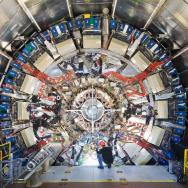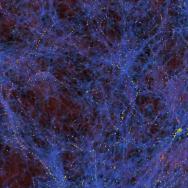A decade has passed since humanity officially discovered what makes our existence possible. On July 4, 2012, scientists announced the observation of the Higgs boson, the elusive particle that gives almost all other particles their mass—and thus lays the foundation for the matter that forms us and everything we see around us in the universe.
The news thrilled the world and made international headlines. Ten years later, scientists explain why the particle was so hard to find, what made its capture possible and what lies in the future.
“The Higgs is fundamentally related to key aspects of the universe. It was wonderful and amazing that we were able to discover it, and how much we’ve learned since then, but from my perspective, the work has only just begun,” said physicist David Miller, one of the many University of Chicago researchers who have worked on the Large Hadron Collider where the Higgs was discovered and where research on it continues.
“We haven’t even asked half the questions that we have about the Higgs.”
‘Hunting the snipe’
“It’s worth saying why it took so long,” said UChicago physicist Mark Oreglia, who counts more than 30 years of his career spent on the search for the Higgs. “It’s a strange particle.”
The Higgs particle is a manifestation of what is known as the Higgs field—an energy field that pervades everything in the universe. “We do not notice it; the Higgs field is like air to us, like water to fish,” wrote the Nobel committee when it awarded the research in 2013.
The particles that make us up, like electrons and quarks, interact with the Higgs field and this sets their mass. But though scientists expected there had to be a Higgs particle, they didn’t know much more than that.
“It was very much like hunting the snipe,” said Oreglia. “You didn’t know how big it was—it could have been tiny, it could have been massive. It was one of those things where you’ll know it when you see it … but you don’t know where to look.”
To search for tiny, undiscovered particles, scientists turn to accelerators. The basic idea is that if you smash particles together with enough force, they will break up into the smallest pieces that make up the universe. But even as scientists continued to build increasingly powerful accelerators that uncovered other particles, the Higgs boson remained hidden.
Finding it would require the Large Hadron Collider—the most powerful particle accelerator ever built, spanning 18 miles across the France-Switzerland border.
‘Lo and behold—there it was’
By the end of the 1990s, scientists—including those at UChicago and its affiliated national laboratories, Fermi National Accelerator Laboratory and Argonne National Laboratory—had discovered and catalogued 16 subatomic particles: all of the predicted particles except for the Higgs. That process, said UChicago physicist Mel Shochet, enabled scientists “to narrow down the range where the Higgs would have to be.” The next step was to build an accelerator that could produce and measure particles in that energy range.
The effort to design, build and operate the Large Hadron Collider involved thousands of physicists, engineers, mechanics and staff across dozens of nations. The LHC is so large that no one country could do it all; instead, individual parts of the accelerator were designed and built all around the world, then shipped to Geneva to be assembled.
The particles would be fed into two different experiments, named ATLAS and CMS. The two experiments were kept as separate as possible, each with their own teams and detectors, so that if both saw it independently, the results would be even more reliable. The University of Chicago worked on ATLAS. Oreglia and Jim Pilcher, now professor emeritus of physics, led a team that built large parts of the ATLAS experiment’s trigger and calorimeter—the instrument that measures the energy of particles produced during the collisions. The devices took shape in the high bay of the high-energy physics building at UChicago, a unique space that allows the construction of such large components.
The team included members of two other unique departments at UChicago: the electronics development group and mechanical services group, both composed of professional engineers that helped the physicists turn designs into reality. “I can count on one hand the number of U.S. universities that have these capabilities, and it was absolutely essential,” said Oreglia.
From planning to first light, the LHC took 26 years to come to fruition. It began its first official run in early 2010. Extremely powerful magnets guided and accelerated beams of protons around the ring until they were traveling at nearly the speed of light, and then smashed them together.
If you crash protons together at these extremely high energies, very, very, very occasionally—about once in a billion times—the collision will yield a Higgs particle. They exist for the tiniest fraction of a second before decaying into other particles. It can be hard to tell a particular spray was caused by a Higgs as opposed to other particles, but by creating enough collisions, scientists started to see a telltale bump in their graph.
“All of a sudden, everything was falling into place,” said Miller. “Lo and behold—there it was,” said Oreglia.
The results were unveiled in a massive multinational press conference on July 4, 2012.
Just the beginning
The initial discovery, however, was just the beginning. “Now you know the mass of the snipe, but you want to know what color it is, if it has feathers, whether it bites—everything else,” said Oreglia.
In the 10 years since the Higgs announcement, researchers have used the LHC to make a number of such measurements with even more precision than they had previously hoped. All these findings help sharpen our picture of the Standard Model of particle physics.
Scientists continue to search for a thread that could unravel some of the other remaining mysteries of physics—such as why there is more matter than antimatter in the universe and the nature of dark energy and dark matter. "Any small deviation in its expected properties from the Standard Model could be a major breakthrough," said UChicago physicist Young-Kee Kim.
For example, it’s possible that when two Higgs particles collide, they create truly invisible particles that are predicted as part of the “supersymmetry” theory. Another possibility is that some collisions will produce two Higgs particles instead of one, and that how those interact will reveal new pieces of the puzzle.
“This turns out to give us the ability to measure one of the few remaining parameters of the Standard Model that has impact on the universe as a whole and the destiny of the universe—that is, how stable the universe is,” said Shochet.
This is one of the main goals for the next “runs” of the LHC. (The detector is periodically turned off for upgrades to bump up the accelerator beam intensity and energy.) Oreglia, Miller, Shochet, Kim and other UChicago researchers have led efforts to design and build instruments and analysis approaches for these next two runs.
The third run, which starts this month and will run for about three years, may provide new evidence for these remaining questions. Miller is working on the “trigger,” the part of the detector that examines all the incoming data from a billion collisions per second and decides what to keep.
“No current data bank on Earth could store that much information at the speeds involved,” Miller said. He and other scientists are looking to machine-learning techniques that can quickly sort through and recognize the most interesting collisions.
Meanwhile, Shochet, Kim and Oreglia’s teams are also building electronics for the fourth run of the LHC, scheduled to start in 2025 at extremely high intensities. The amount of power will offer newfound opportunity to explore fundamental mysteries, but it also presents its own challenges.
“The devices we’re building will have to absorb quite a large amount of radiation, so one of our challenges is to find new ways to make the electronics radiation-tolerant at reasonable cost,” Oreglia said.
Other UChicago scientists have been involved in building the computational techniques and cyberinfrastructure needed to capture and analyze the data, and doing theoretical work such as suggesting how to use the Higgs to detect dark matter.
Once elusive, the Higgs itself is becoming a tool to open doors.
“The story of the Higgs is not finished yet,” said Oreglia. “It will be wildly exciting to see if it connects us to some new world.”

